Swimming with whale sharks in Mexico is undeniably a bucket list wildlife encounter. Watching a vast shadow materialise out of the blue and coalesce into the sleek, spotted behemoth of the world’s largest living fish is a thrill that stays with you long after the moment has passed.
As one of the planet’s more accessible ‘big wildlife’ encounters however, more and more people are joining whale shark tours each year, and there’s a very real risk that our desire for close-ups with these gentle giants may end up doing more harm than good.
It’s a sense that we took away from our own whale shark trip in Mexico: while we loved every second of our time in the water with these spellbinding creatures, the experience left us in two minds about whether we would do it again.
Mexico: A Whale Shark Mecca
Like John and I, whale sharks prefer the warmer waters of the planet’s tropical and warm temperate regions, and you can find them from the coasts of Indonesia and the Maldives, to the waters off Australia, Mozambique and Mexico.
While the harmless filter feeders – which can grow up to 12-metres long and weigh over 10 tons – spend most of their time cruising the open ocean hoovering up plankton and small fish, they gather together in large groups off coastal areas at certain times of the year for great feasts, often during fish and coral spawnings.
These gatherings, called aggregations, are usually the best time to see whale sharks and Mexico’s Yucatan Coast on the Caribbean Sea is one of the most reliable whale shark aggregation spots in the world. Consequently, it’s also considered one of the best places to swim with whale sharks. This, along with diving the Yucatan’s reefs and cenotes, was the drawcard that brought us to Playa del Carmen in Mexico.
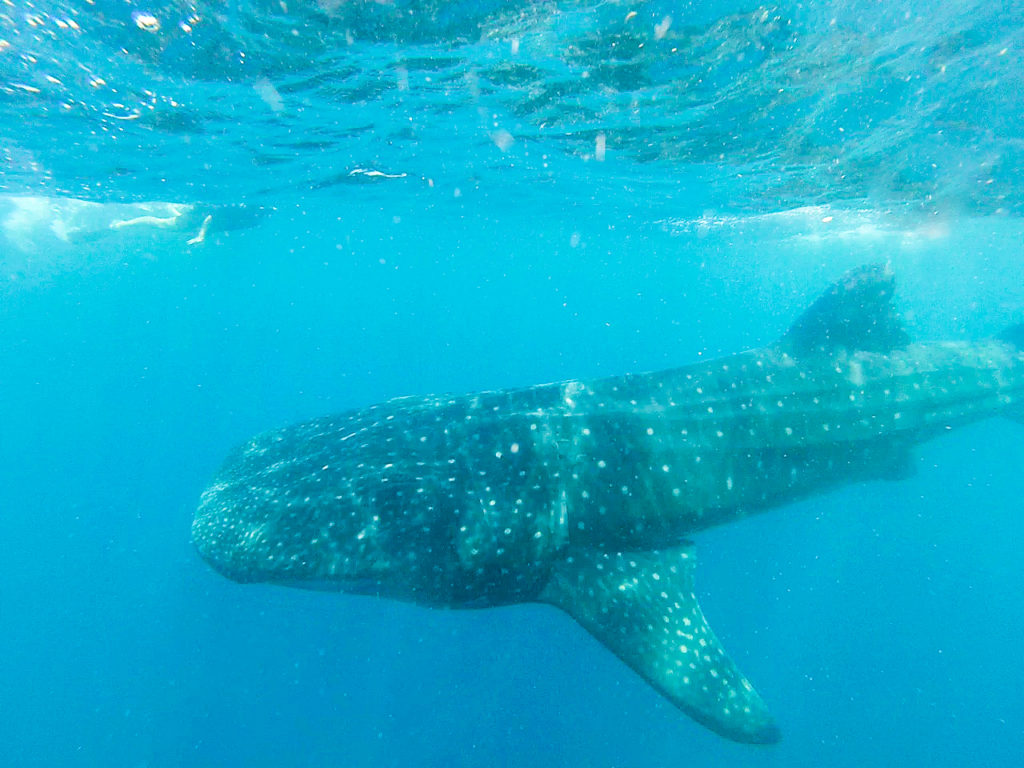
A Caribbean Buffet For Giants
With 10% of the world’s coral reefs, deep waters and sheltered bays, it’s not surprising that the Caribbean Sea is a hotbed of whale shark activity.
Between May and September each year, the Mexican corner of the Caribbean turns into a buffet for giants. For many years, an island off the tip of the Yucatan Peninsula, Isla Holbox, was famous for attracting whale sharks and manta rays to its shallow waters to feed on plankton.
In recent years though, the sharks have been gathering in large numbers further out to sea, north of Isla Mujeres, where nutrient-dense upwellings of water make for rich feasting. More than 400 whale sharks were spotted in this area in one dinner sitting back in 2011, and this is still one of the world’s largest annual whale shark aggregations.
It’s also fast becoming one of the world’s largest annual aggregations of whale shark tourists.
Our Whale Shark Experience
Swimming with whale sharks had been on our lust list of wildlife encounters since we first put a bucket list together, so we were beyond excited at the prospect of finally seeing the huge fish in the wild.
As with any experience, and especially those involving wildlife, we researched our whale shark tour options extensively. We were looking for a professional, small-group outfit with proven eco-friendly practice and, above all, a clear respect for the whale sharks and the rules in place to protect these endangered animals.
Throughout our stay in Playa del Carmen, we were approached on a daily basis by touts on the street offering cheap whale shark tours. We ignored them all in favour of finding and booking our own operator. We finally settled on a company with solid reviews and all the right words on their website. It was quite a bit more expensive than the street touts were offering, but we wanted the assurance that we were travelling with a responsible, high quality outfit. We went ahead and arranged our tour direct.
On the day of our tour, we were collected by another company. We were expecting this; the company we’d booked through had told us outfits often grouped together for pick-ups.
When we arrived in Cancun, however, we were channelled into a large and rowdy sign-up area jammed with dozens of other tourists. Our names were marked off, we were given a coloured wrist band, told to pick up our hired wetsuits and wait to be called. The name of the company we had booked with was written against our names, but never mentioned.
In the time we waited, dozens and dozens of tourists passed through the check-in area and milled out to the waiting boats. Boat after boat departed the docks. We supposed the people wearing our coloured band must all have booked through the same company. We didn’t think to ask.
Eventually, with our group all together, we made our way out of the docks, the last boat to leave. Our guide and captain were wearing shirts from another company. We wondered but sat on it.
We set out for an aggregation spot on the open ocean around two hours from Cancun. We had big seas on the way out that day and our little speed boat smacked the waves so hard we worried we might crack a vertebrae. Big swells aren’t unusual on this tour though and trippers are advised to take sea sickness tablets before heading out.
When we at last reached the aggregation site, there were literally dozens of boats already there. We hadn’t been expecting the site to ourselves, but the sheer number of boats in the area made it difficult to believe we were in for a whale shark-friendly experience.
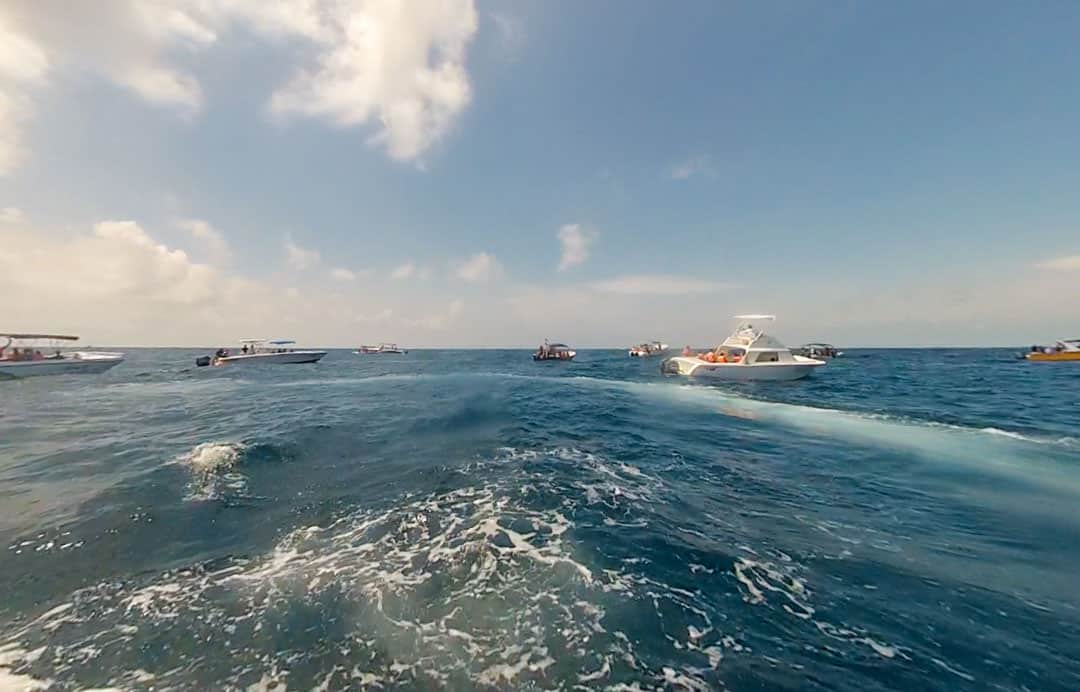
Our guide explained the rules and regulations for snorkelling with whale sharks. He also pointed out a boat nearby with monitors making sure rules were followed. The process was simple: we would search out whale sharks, slow the boat near to the shark’s trajectory, and take turns – two at a time – slipping in to the water with the guide to swim with the whale shark as it passed by.
Within moments, it became clear how difficult it was for captains, guides and those in the watch boat to monitor and manage such a busy site. Whale shark fins cut through the water in every direction, but there were also snorkellers bobbing about everywhere, and boats zipping by in pursuit of both.
Before we even had our own people in the water, our captain was shouting at a swimmer from another boat trying to grab the dorsal fin of a passing whale shark. John and I glanced at each other, wide eyed. This wasn’t what we’d imagined.
By the time our turn rolled around, we slipped into the water with some trepidation, but our whale shark was already past us and on the move. It was fleeting, but a rush all the same.
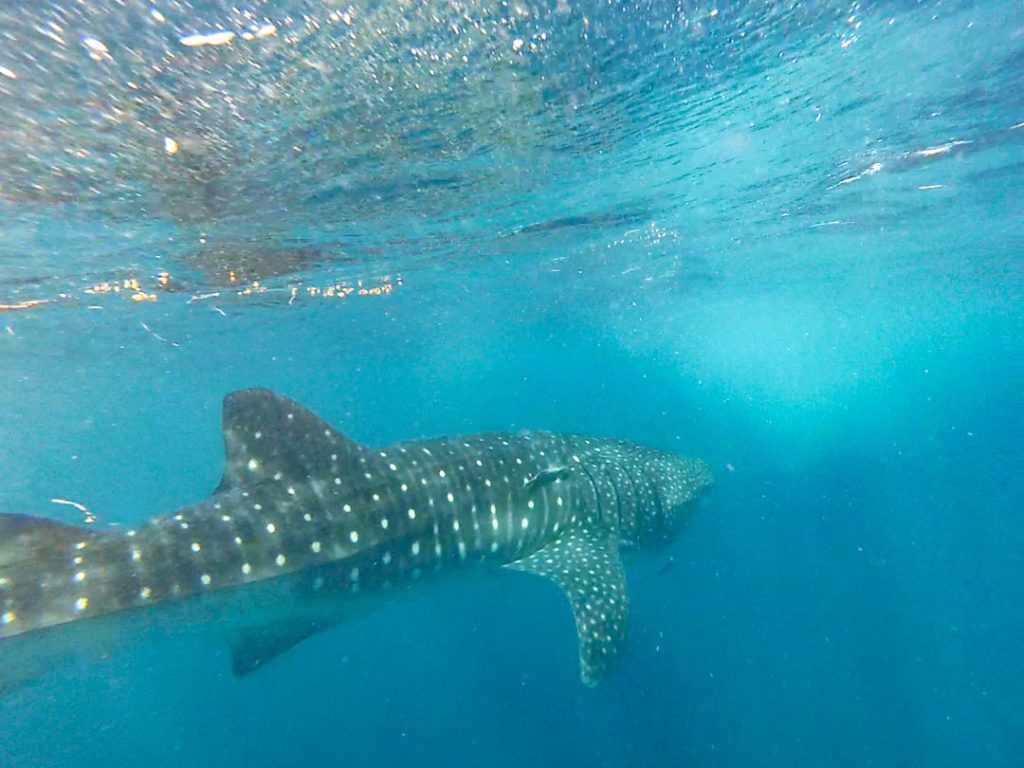
On our second attempt, we slipped in just as another boat roared in ahead of us, dropping a snorkeller into the water almost on top of us and cutting us off from the whale shark we were waiting for.
It was the final straw for our conscientious captain, who had been calling out reckless swimmers and boats since arriving. As we climbed back aboard, he grumbled in Spanish at our guide and began steering the boat slowly away from the cluster.
“The captain wants to take us somewhere less crowded,” our guide told us. We breathed a sigh of relief.
We didn’t need to travel far to leave the cluster behind. Within moments, we cruised into an area with a handful of well-spaced boats and several whale sharks cutting the surface with their fins.
We dropped back into the water for our last attempt and it was then that we experienced the true magic of a whale shark encounter. The entire event – from the moment we slipped into the sea, to the final flick of the creature’s majestic tail as it finned off into the deep blue – lasted barely minutes, but when we surfaced, we were euphoric.
Here’s a video of our experience below:
Back on the boat, we were buzzing with excitement. As we thumped our way back to the mainland though, we began to question whether the experience of swimming with whale sharks in Mexico was one we could positively recommend to others.
The Other Side Of The Story
Whale shark tourism is fundamental to many communities. It provides employment for local people and gives a vital boost to local economies. There are also plenty of responsible whale shark tourism operators who respect the animals that underpin their industry, and actively work to protect them both by enforcing the rules and regulations among their colleagues and visitors. This is no doubt the case in Mexico, considered one of the world’s more progressive whale shark tourism players.
However, as the industry grows and more people participate – tourists as well as licensed and unlicensed operators – those rules and regulations become harder to moderate.
We saw this in action on our trip. Regardless of the best efforts of responsible boat captains such as ours, and the under-resourced monitors doing their best to keep order, it only takes one unscrupulous and competitive boat driver, or a reckless snorkeller, to create a chain effect of bad behaviour, putting the whale sharks under stress and at risk, not to mention the safety of swimmers, and tarnishing the overall experience.
This National Geographic video looks at the pros and cons of Mexico’s whale shark tourism industry:
What’s The Solution?
We’ve always been firm believers that in order for people to feel a connection with and care about the environment, they need to experience it. Swimming with a whale shark in its natural state, feeling that incredible sense of awe, leaves an indelible mark. People should be able to access that.
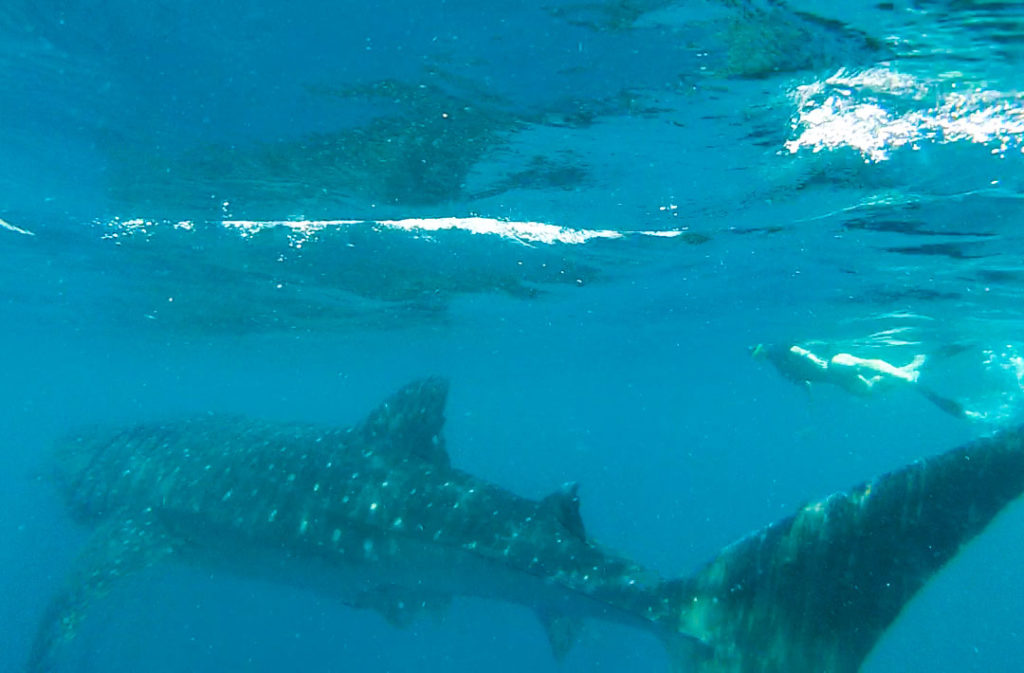
On the other hand, our experience convinced us that – for the sake of the whale sharks – there must be limits on the number of boats and people interacting with these magnificent creatures at any one time.
Sure, this would effectively make the experience more exclusive, which isn’t necessarily fair. But as we found when we trekked to see gorillas in Rwanda, and when we wandered through fields of sun-lounging marine iguanas on the Galapagos Islands, restricting access means that the stress and impact on the animals is reduced, and the people who are there put a high value on being there. It also means the resourcing is available to enforce regulations more effectively.
The Importance Of Doing Research
Back on shore later that afternoon, we got talking with a couple from our boat. It turned out they’d booked their whale shark tour through a street tout in Playa del Carmen and with a different company. Better still, they’d paid half the price that we had, for exactly the same experience.
It was a dark underscore on a day we already had mixed feelings about. At least the captain and guide we’d gone out with, despite being from a different company to what we booked, were responsible, conscientious operators. Had we been on another boat out there that day, it might have been different.
For us, it reinforced just how important it is to research experiences and operators. We thought we’d done enough investigating, but on digging deeper afterwards, we found red flags about the experience that we should have paid closer attention to. Of course, hindsight is a wonderful thing. So is sharing that hindsight.
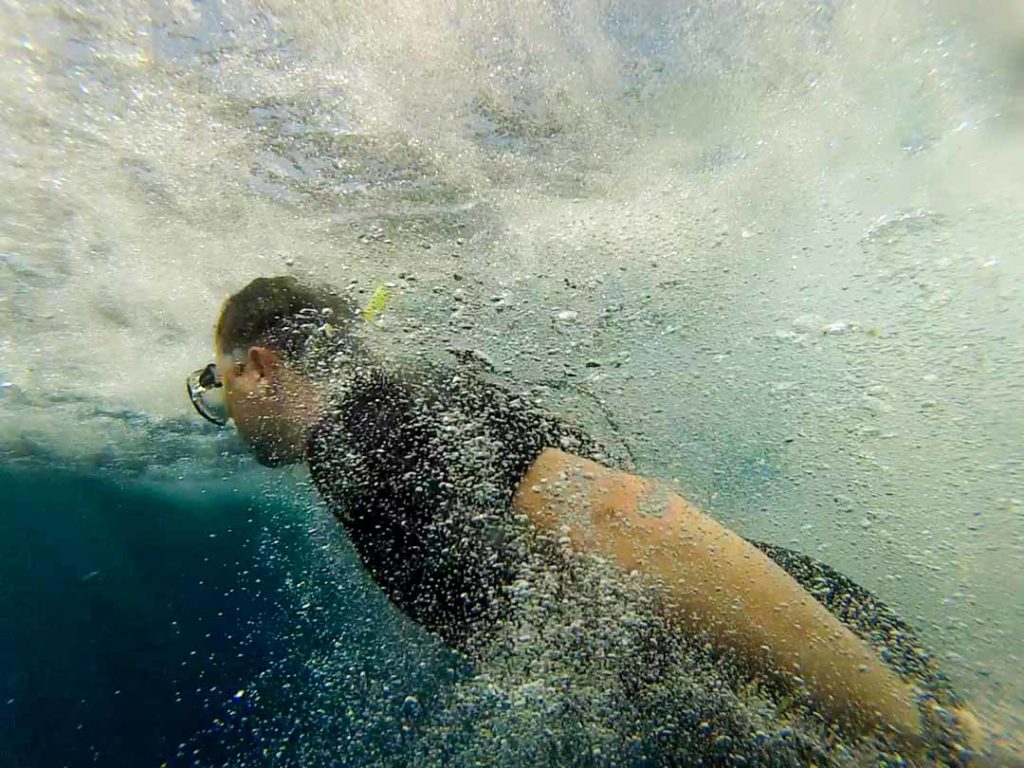
So Should You Swim With Whale Sharks In Mexico?
It really is an incomparable rush to encounter the world’s largest living fish up close. Based on our experience though, we hesitate to recommend swimming with whale sharks in Mexico, at least until licensing and regulations are further tightened on the number of boats and people in the water at any one time, and greater investment is made into enforcing the regulations. This has apparently worked well in other places, like Ningaloo Reef in Australia, where there are seasonal quotas on people in the water.
Without having experienced whale shark tours anywhere else, we can’t comment on other places, but we recommend doing as much research as you can before you sign up. Look into the local industry and find out how it’s being managed. Read all the reviews you can find, and probe further where questions are raised. Find an operator with a solid record of responsible, sustainable ecotourism practice, and make sure they’re the ones taking you out on the day.
The opportunity to snorkel with whale sharks is one of nature’s gifts and one of the most exciting wildlife encounters we’ve had. It cannot be taken for granted. We’ll never regret our experience in Mexico; learning is a big part of why we travel. If we ever get in the water with whale sharks again however, it will be in a place that manages the experience well. That may yet be the Yucatan Coast. We hope so.
We booked our trip with Cancun Whale Shark Tours, operated by the Whale Shark Daddy. On the day, we travelled with Caribbean Connection. We were later advised that the two companies are actually partners and co-own boats and facilities. This was not, and still isn’t, clear on either company website.
What are your thoughts? Have you been swimming with whale sharks? We’d love to know about your experience, let us know in the comments below.

Loved this! We were also wrestling with a similar dilemma. Thank you for such an informative piece 🙂 Glad we chose not to do it in the end.
Hi Alice, many thanks for your message and for reading our post. Wildlife experiences like this are truly special but it’s so important they’re managed well and put the welfare of the wildlife first. It’s our sincere hope that things have improved in this destination since our trip. We also hope you do get to have an incredible whale shark experience with a fantastic operator in the future! All the best!
Yes for sure with the high quality control outfit we can swim with a whale shark
I hope you’re right, that would be good to see.
Yes, for sure. 🙂
That was a well researched, balanced and informative piece of writing. I am in Cozumel, and here during the season to swim with the whale sharks. I have been wrestling with the issues too. I found very little information that informed well, except that is for this piece here. Thanks to you both, i will wait until there are better licensing and regulations, though it breaks my heart a little to say so. 🙂
Hey Jo, really glad this was useful, and yes, I can imagine it would be a tough decision not to do it, but if we had our time again we wouldn’t. Please keep us posted on any different perspectives you hear on the issue while you are in Mexico and let us know if you find examples of this being done in a sustainable way.